Have you recently started a business for your blog?
This means when you want to monetize your mommy blog, you are starting a business mama!
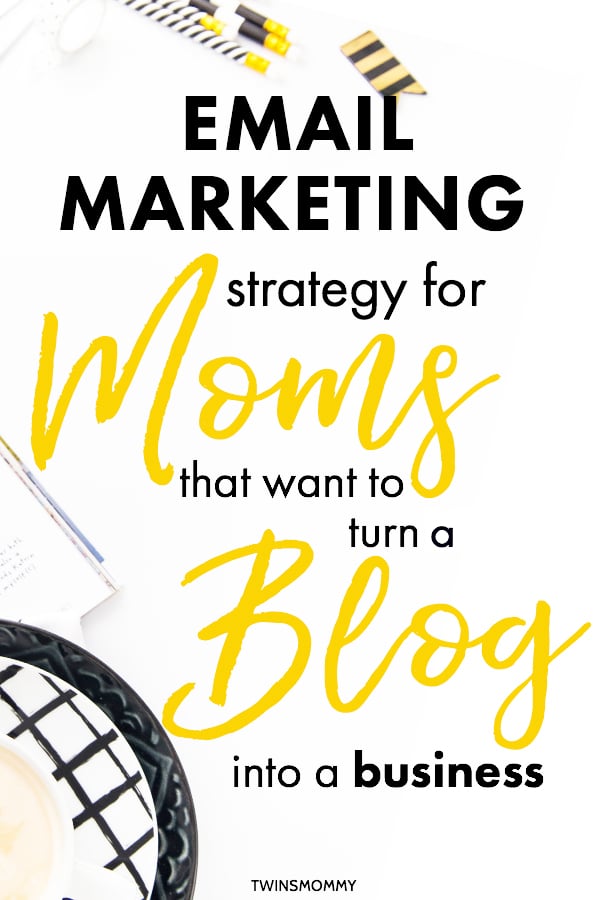
Going from blog to business usually starts with an email list.
Why? Because once you start collecting email addresses from your readers, you can start developing a connection and a relationship that’s unique to you and your blog.
You get to know your email subscribers on a deeper level.
But having a blog also gives you that connection, right? We create info-packed posts with beautiful pin graphics in hopes of someone reading it, commenting and wanting to learn more about us and our blog.
Well, an email list is so much more than all of that. It’s a personal message you give to loyal followers.
When someone gives up his or her email address in exchange to learn more about you, it’s like gold! They are the ones that will tell their followers about you and connect with you.
Why You Need an Email List

Starting an email list also has some advantages too. For starters, it trumps social media.
You own your email list; you don’t own your social media followers. If Facebook decides to close its doors, then you have no more Facebook followers.
Essentially, you’re growing your blog on rented land when you build your audiences on Pinterest or Twitter.
And while growing your social media followers is nice and everything – and it can help grow your brand and credibility – there is no real connection with your followers. They may not see every time you post, and you can only hope they will see your next posting.
At least with email, you’re in a subscriber’s inbox, and for a lot of bloggers, this is a sacred place. Only the best of the best are in many blogger’s inboxes. So, when they open and read your email, that’s a small win for you!
Getting an email address is really the first step in figuring out who your reader is and hopefully, who your customer is.
And the best advantage to having an email list? You can grow your income! It’s been proven that email converts better than any other medium – social media or content marketing.
The more subscribers you have, the more potential income you can earn.
How?
By understanding your subscribers and providing them the best resources to help them along their journey. And those can be your services or digital products.
If you want to use email to your advantage to help you grow your blog’s income, there are some foundational concepts you should understand to make sure you are emailing right.
This post will go over the important and critical concepts to help you understand email marketing for your business as a mom blogger.
What is Email Marketing?
If you’re a brand new blogger, I’m sure you’ve been hearing, “start an email list” and, “it’s the only way to make money.”
While I do believe having an email can help you grow your income, it isn’t the only way.
As a blogger, you use an email service provider (ESP) like:
- ConvertKit
- MailChimp
- Mailer Lite
You send your emails using those services. By emailing your subscribers, you create a new relationship with them! They may email you back telling you their story or they may just email you saying what a great email you gave them!
By having that 1:1 connection, you can really grow a loyal tribe that will read your blog posts, advocate for you and eventually buy from you.
The process of email marketing can mean:
- Segmenting your email list – With ConvertKit, you can easily segment your list to only email a certain group of people. For example, those that grabbed your Pinterest freebie vs. those that grabbed your breastfeeding freebie. You want to tell your Pinterest email subscribers about some great Pinterest webinars and don’t want to bother your breastfeeding subscribers about this. Segmenting is a great way to target your email list and reduce unsubcribe rates.
- Tagging your list – You might be offering multiple freebies. To categorize who opt-ed into what freebie, you can set up tags in your email service provider. I have tags for my free email courses, welcome series and freebies.
- Creating a sales funnel – When you have a product to offer your list, you can set up a sales funnel to help grow that income. This can mean providing educational emails, agitational emails and solution based emails (your product) as a simple sales funnel!
You don’t need to know all the technical stuff with your email service provider RIGHT NOW, but I wanted to share with you what you CAN do with an email list.
So, let’s look at some marketing strategies to understand email marketing for moms.
The Key to Hitting The Inbox
You have your first email written for your brand new subscribers. Yay! It’s submit time.
But, little do you know that your newsletter may not get to the inbox of your subscribers.
In fact, in the marketing world, more than 60% of marketing emails don’t ever make it to the inbox.
What?!!
Is this fact real? Does it apply to my lovely non-marketing newsletter? Yes. It does.
Where does it go? To spam or Promotions. Here is my promotions tab:
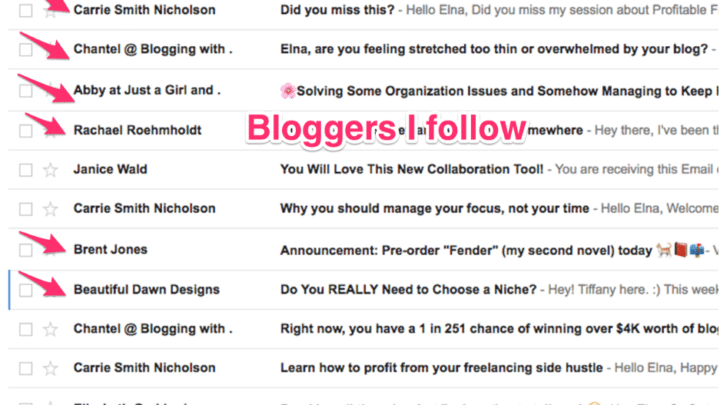
A lot of bloggers I follow on social media and read their blogs often are sending their emails straight to the Promotions tab.
Unless I check this tab (which I rarely do unless it’s the first of the month and I’m waiting for my free stock photos from bloggers), I will never read these emails.
This, unfortunately leads to poor communication with your list and it’s very hard to nurture your list if they aren’t even receiving your emails!
Now, don’t get this confused with deliverability and your open rate. When you see your analytics from your email campaign (fancy speak for after you sent your newsletter and wait for the results), the open rate percent tells you only if the email was sent to the recipient.
No matter if it went to their Promotions tab in Gmail or their Inbox.

Instead of focusing on your open rate, focus on trying to hit the inbox with the emails you send to your subscribers.
This will help you get an engaged email list of subscribers who will (hopefully) buy from you in the future. Let’s look at how to set up your successful email marketing strategy as a way to ensure your emails hit the inbox as much as possible.
Start Building Domain Trust (Domain Reputation)
When you receive an email, you probably just..read the email. Maybe you reply, maybe you file it to a folder, or maybe you flag it for later.
But there is a whole hidden part to every email that nobody knows about or thinks about – called the email headers – and it contains information such as who sent it, what servers it traveled through, and if it came from a trustworthy and verified source.
When you send your email to somebody with a Gmail address (or Outlook or Yahoo or any other email service provider), Google (or Microsoft or Yahoo or whomever) receives that email, processes it, and runs a number of test and algorithms over the contents and headers of the email…in an attempt to determine if the email should be rejected or accepted for delivery.
Rejection usually happens to email from very spammy or incorrectly configured email servers…not something you should have to worry about.
Once an email is accepted for delivery, the email service provider classifies the email as Spam or not, and then in the case of Google, it classifies it as Promotional or not.
What this means is the contents and subject line of your email matters – you don’t want to use inherently spammy terms like “Make Money Online Now!” – but what also matters more is the source of your email, and WHO is sending it. Your sending domain – which for most people is your blog or website domain name.
If you always send your emails from [email protected], and they are high-quality emails, sent to responsive and engaged subscribers who open your emails and sometimes reply, and that don’t generate spam complains, eventually Gmail and others come to learn that people WANT to receive email from [email protected] and that Elna sends “good stuff.”
This is building the domain trust of twinsmommy.com, and it improves your deliverability, keeps you out of the dreaded Spam folder, and greatly increases your chance of avoiding Google’s Promotions tab.
Of course the way this whole process works is a highly guarded secret that the email service providers don’t share for obvious reasons (they don’t want to give any clues to professional email spammers).
But we do know from experience that building your domain trust is always a “really good thing.”
In my case, when I started my email lists, they didn’t go to Spam, but they mostly went to Gmail’s Promotions tab.
And this makes sense. When you are new – or if you don’t have a lot of subscribers or you don’t email them frequently – your sending domain is essentially a blank slate to Google (or Microsoft, Yahoo and others).
You could be good, but you could be bad. So they often err on the side of caution, and put your emails in the Promotions tab.
As you start to email more and build up your domain trust over the course of a few weeks, you should see more of your emails move out of Promotions and into Gmail’s Inbox.
That’s what happened to me and now, with the use of my custom email template and authenticated sending domain, my emails go to the Inbox more often than not.
Single Optin vs. Double Optin

When setting up your email list and deciding on your email strategy, you have the option to do single optin where a blogger signs up to your email list to receive your lead magnet (or freebie) and gets the freebie right away.
Or, double optin, where the blogger signs up to your freebie and then has to confirm their subscription to your email list before they can receive the freebie.
There are many reasons why you would want a single optin or double optin.
1. Double Optin Ensures Responsiveness
When a reader comes to your blog, reads your post and is interested in the freebie and then goes on to sign up to your list, check their email and click on the confirmation link that they are on your list, it shows high responsiveness.
This is a subscriber that wants to know you and wants to follow you.
2. Double Optin Creates a Quality List
When you make your freebies double optin, it helps reduce the the likelihood of people just signing up to your list for the freebie only.
3. Single Optin Grows Your List Faster
If growth is on your radar – which it should be if you want to create a service or product in the future – then single optin can help you out.
With single optin, you remove those extra barriers – checking the confirmation email and then clicking on the link before receiving the freebie – making it much more likely that someone will sign up to your list.
But when you use single optin, you need to make a habit of pruning your list, at least monthly, to remove unresponsive subscribers and invalid email addresses, and to keep engagement and open rate high.
4. Single Optin Reinforces New Subscribers
I don’t know about you, but getting instant access to anything is awesome. It’s exclusive and reinforces how awesome that blogger is.
By giving your readers instant access to your PDF guides, checklists, email courses and more, you can gain their trust quicker.
The downfall to single optin however, is a poor response rate. People will just sign up for the freebie and not open any other emails from you.
But, there ways to grow your responsiveness with a single optin. This is called nurturing your list and by putting in place certain elements, you can raise the responsiveness and engagement.
Here are three effective ways to nurture your list.
Promptly Respond
While new subscribers probably don’t want to be inundated with your emails, it’s a good idea to provide a welcome message as soon as a visitor opts into your list.
An hour after a blogger signs up to my list and downloads their freebie, they are put into a welcome series.
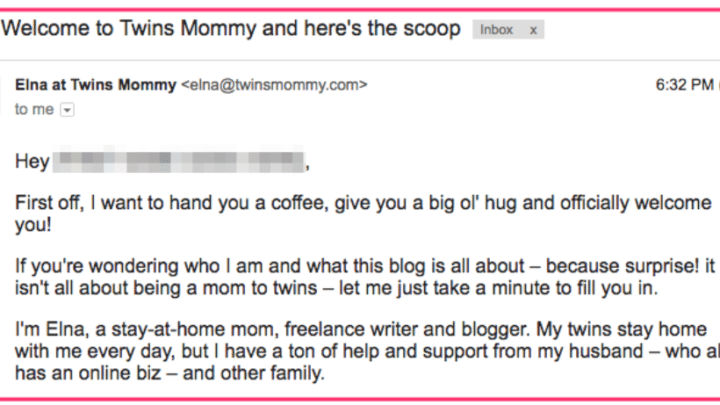
Try sending your welcome email soon after they receive their freebie. New subscribers can go cold within 90 minutes of signing up to your list, so act fast.
Provide Value
Don’t fall into the trap of emailing your list every week just letting them know of your latest blog post. Your subscribers want insider tips, more freebies and exclusive content.
For example, for my Twins Mommy list I email about the behind-the-scenes of my business and let my subscribers know what projects I’m spearheading and what I’m doing to grow my blog.
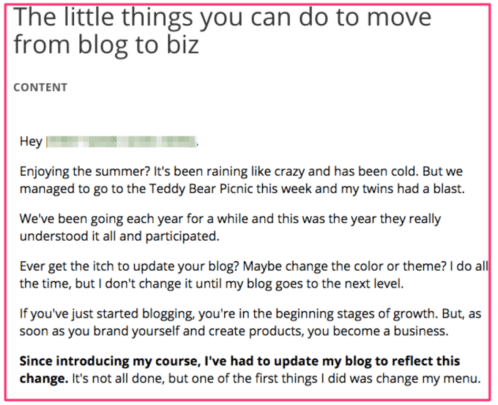
Use Their Name
When you personalize your emails with the subscriber’s name, you make a connection with them. It feels like a friend is emailing them.
You can use their name:
- In the subject line
- In the introduction
- Within the email
What’s Better? Single or Double Optin?
There is no right answer to this question. In the beginning, you may lean towards double optin as this ensures a quality list and builds your early list reputation.
But, when you start concentrating on the growth of your business and trying to grow your email list, you may want to start using single optin.
How Your Emails Can Avoid Spam Filters

When you have your email list, you’ll probably spend hours painstakingly crafting an email for your list. But after you send it, you only get a poor open rate in return.
Why?
The number one reason your email isn’t read is because it automatically gets sent to the Spam (or Promotions) folder by your user’s email provider (Gmail or Outlook for example).
There are two main reasons your emails don’t end up in the Inbox:
- Emails are flagged by a spam filter. Spam filters are computer programs designed to search for certain things in email messages and flag the message as spam if it crosses a predetermined threshold. Each email provider has their own top-secret filters that look for: common spam signatures in the email headers, common spam words in the subject and body, high image to text ratios, and more.
- Too promotional. If all you do is promote, promote, promote and rarely provide valuable content, you’re destined for Gmail’s Promotions tab all the time. There are many other reasons why your email could be classified as Promotional, but building a good list reputation and domain trust by sending quality content and asking for engagement goes a long way to getting your emails in the Inbox.
Now, for the average blogger, this shouldn’t happen, but the first reason is much more probable.
I briefly discussed how most of the bloggers I signed up for their email list go to Promotions in my Gmail account. I also went into foundational elements to make sure your email list is clean, positive and primed for your marketing efforts.
Let’s dive into the actual email and how we can format it better so that you have the best chance of avoiding an automated spam detection filter.
1. Get on Your Subscriber’s White List
Your email provider – Gmail, Yahoo, Outlook etc… – allows you to add specific email addresses to your contacts list. This is whitelisting.
Email sent from these addresses typically bypass the spam or Promotions folder and is delivered straight to the inbox.
The easiest way to reliably get into your subscribers’ inbox is to ask them to add you to their contacts list.
In my welcome email, I give my new subscribers instructions on what they can do right now:
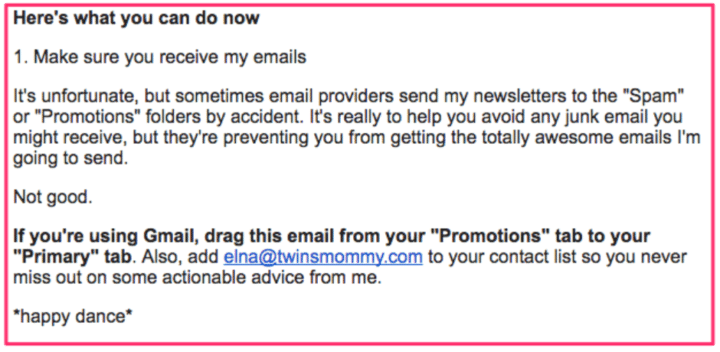
I let them know what happens to a lot of emails and then give them steps to drag my email from the Promotions tab to the Primary tab if they are using Gmail.
I cover all my bases by providing my email address and asking them to put that email address in their list of contacts.
This gives me some assurance that my subscriber is invested in my email, that they want to receive more from me, and will (hopefully) whitelist Twins Mommy.
You can also ask your new subscriber to whitelist you on a Thank You page or in the confirmation sign up email (if you are using double-optin).
2. Send a Test Email
Before you email your subscribers, send a test email to yourself or a family member/friend.
If it goes straight to your Spam folder then you need to reevaluate your message.
If your email doesn’t end up in the Primary tab – the inbox – your open rates will suffer. Try rewriting your test email’s subject and/or tweaking its content, and sending again.
When the email finally reaches your inbox, go ahead and send it to your list.
It’s not always possible to avoid the Promotions tab – especially if your list is relatively new and doesn’t have a lot of history and domain trust – but do your best to create quality, unique content that isn’t too “markety” or promotional.
3. Comply With Spam Laws and GDPR (Country-Specific)
If you are a business/blogger operating (or sending email to people) in the United States and you’re sending “any electronic mail message, the primary purpose of which is the commercial advertisement or promotion of a commercial product or service,” then you must abide by the CAN-SPAM Act 2003.
The main requirements are:
- Don’t use deceptive subject lines
- Tell the recipients where you’re located
- Tell recipients how to opt-out of receiving future email from you
- Honor opt-out requests promptly
- Monitor what others are doing on your behalf
These requirements must be followed, or you could face penalties of up to $16,000 for each offence – that’s $16,000 for each email on your list that you spam.
Most other countries have similar laws, such as Canada’s CASL or Europe’s EU Opt-in directive.
I don’t want to scare you with these laws, but you should be knowledgeable of them based on where you live.
Most email service providers have made their email templates comply with the CAN-SPAM Act. In addition, if you’re using a custom template or if you’ve modified a default template and forgot to include an unsubscribe link, most email providers will automatically include it (and your mailing address) in the email’s footer.
It’s that important!
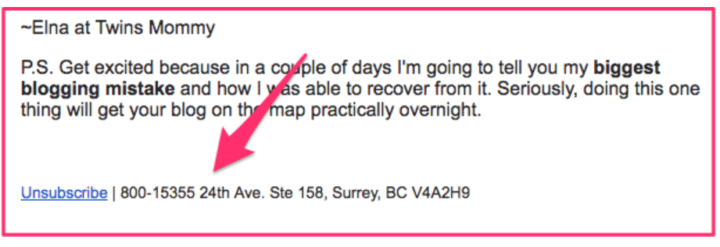
And as long as you are providing value to your subscribers, not overly marketing to them and not misleading them, then your emails should comply every time.
GDPR – General Data Production Regulation is in full effect for online bloggers and business owners. Email service providers have ensured that their email service provider is GDPR compliant. For more information, check out this guide.
4. Watch Your Images
Be mindful when including images in your email newsletters – especially if your messages are short.
Mailchimp flagged, “too many images, not enough text” as the top reason many emails set off filters.
Spam filters can’t read images so spammers can use them to conceal trigger words that would normally get their email flagged.
Many email providers and desktop email clients like Outlook block images as standard anyway, so depending on your user base, you may want to consider if sending your image is worth the risk at all.
I seldom put images in my emails, but when I do I try to let the subscriber know:
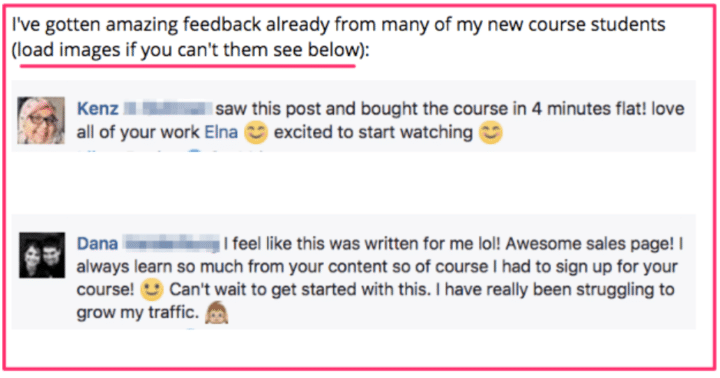
If you can, try to avoid filling your email with images or it will probably land in your Promotions tab or worse, the Spam folder.
Most of the free stock photo bloggers I signed up to go straight to the Promotions tab. Why? Because their emails have a ton of images (of course!)…and many are using default templates from their email service provider.
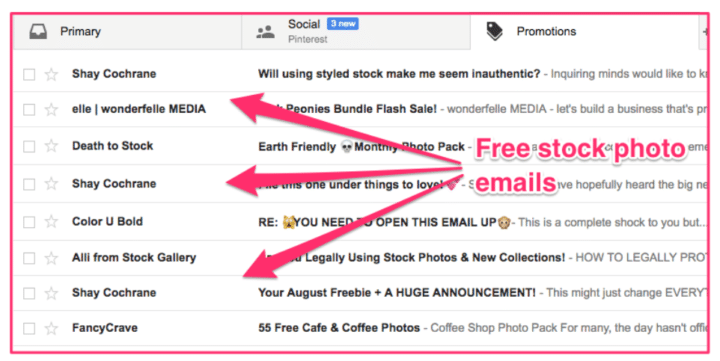
5. Ask for a Reply
A hack you can use to increase and strengthen your email reputation (i.e. lowering the chances of your emails going to spam/promotions), is to ask your subscribers to reply to your email.
This also helps you to understand your audience and get closer to your subscribers, creating an engaged email list.
How do you ask for a reply?
In my emails I usually end my email by asking my subscribers to share their blog (or product) or to tell me their challenges.
Remember, just have fun with your emails, provide value and exclusive tips. If you format your emails the right way, you’ll have a better chance avoiding the spam/promotions filter.
P.O Box vs Home Address
Legally, you’re required to include your “physical” address and an unsubscribe link in each and every email you send.
You can use your home address, and many people do. When my husband and I were young with no children and living in a downtown high rise condo with security, he used our home address. There was never an issue.
Now, and especially if you have a family, I recommend using a PO Box or some other type of mail drop like a UPS box.
If you’re on a budget, then you can probably use your home address and nothing bad will happen (I’ve never heard of something bad happening), but if you can swing it, at an average of $100/year for a P.O. box, it’s a small price to pay for some privacy and security.
P.O. boxes come in handy too for online shopping!
Pretty vs. Plain Emails
Many email service providers have pre-designed email templates you can use for your newsletters.
They look pretty, brandable and seem like a good choice if you are building your brand.
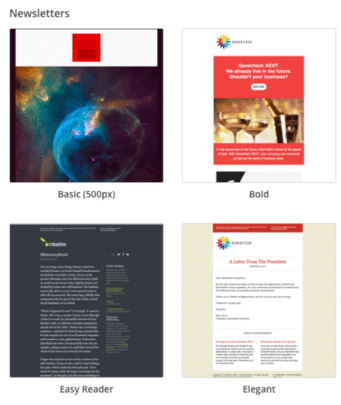
But, you don’t have to use a template; you can also just put your logo at top of your newsletter.
But, there are two trains of thought – if you’re a big brand like Target you need to use a fancy template because that’s what readers expect from a big brand. An unstyled email would seem like a phishing email and distrustful.
You’ll see most big brands use pretty templates, but since you’re a blogger and you’re trying to build a personal connection with your subscribers, it’s best to use a plain template. One that looks like someone just opened up Gmail and started typing an email to you (I use a slightly larger font but the rest of my email look exactly like a default Gmail email).
This way it makes it look like your emails and newsletters are coming from a friend or real person. First impressions count, so when someone opens the email, if they see all these fancy and flashy design elements, their brain will immediately decide it’s promotional.
If you want to build an email list that you can nurture and monetize, then it’s best to keep it simple and use a plain email template.
Some will say to use pretty emails in all circumstances, but the above is my experience and opinion (and the opinion of many other bloggers and email service providers targeted to bloggers and solopreneurs).
Best Times to Send Emails

Besides trying to avoid the promotions tab, you also want to make sure you are sending your newsletters at the optimal time your subscriber will want to read your email.
You also want to send it on a day that will get the most engagement too.
But what is that?
Based on proven analysis and reports here is what the best day and times are.
The Best Day to Send Your Email
According to research, Tuesday is the best day overall to send your email. Wednesday is a close second and if you send multiple emails (2 a week) make the second email on Thursday.
It seems that the middle of the week is the best time to send your email and generate the highest open rates.
I send my Twins Mommy list an email typically on Thursday, but sometimes on Tuesday.
I find that my open rate is the same on either day, but that’s the expectation I have with my list of them knowing when I send my emails.
The Best Time to Send Your Email
The long standing report in email marketing has always stated that 11 a.m. is the best and optimal time to send your email.
Also, many email service platforms’ default time is within this optimal time frame.
So, do exactly the opposite! If everyone is sending their emails at 11 a.m., pre-empty them and send yours at 10:30 or even 10:45!
But, recently, some new times are becoming more popular:
- 8 p.m. – midnight. People like to check their email before bed.
- 2 p.m. This is the time when people are in a lull or need to distract themselves from a task.
- 6 a.m. Many people check their email first thing in the morning.
I typically send my Twins Mommy email anytime between 9 a.m. – 11 a.m. If I’m running late (which is often with my twins…ha), then it’s closer to 2 p.m.
Based on your audience (whether they work, go to school, have young children), you can tailor the time you send your emails.
Create Your Best Day and Time
With saying all of this, if you “follow the herd” and send your emails when everyone else is sending their emails, your might get lost in a subscriber’s inbox.
So play around with your day and time like I am and look at your analytics to see how many people are engaging with your emails during what day and time.
What to Email Your Brand New List
Okay, so we’ve talked about the ins and out of the email service provider features and ways to boost your email marketing strategy. But, what do you do with that brand new email list?
The first thing is finding a way to start growing that email list, right?
You can do that effectively by creating a freebie or opt-in incentive. This can be a:
- Checklist
- Guide
- eBook
- Printable
- Planner
- Video
- Couse
There are many incentive ideas that can help you grow your email list as a mom blogger. You won’t know if that idea will work unless you try it out! Not every freebie idea will be the winner.
It can take several different ideas and it might take you months or a year or more to really find that one freebie that works on autopilot.
I suggest creating new freebies as much as you can. The easiest way to create a freebie is with ConvertKit.
The next thing is setting up a schedule to email your subscribers.
How often will you email your subscribers:
- Daily? – You run the risk of burning out and “spamming” your list
- Weekly? – Weekly is the best schedule to send emails to your subscribers. “Be on their brain” weekly so they don’t forget you.
- Bi-Weekly? – This may work if you have a large email list or if you give that expectation to your list. For example, you let them know that you email bi-weekly.
- Monthly? – This may work for blogs that have a lot of content. They can compile a list of their latest blog posts and send a monthly blast.
But, as I mentioned, the best way to nurture your email list is to make sure you are in their inbox at least weekly for regular newsletters.
What do you send your email list? For ideas, make sure to check out this post!
Some ideas include:
- Behind the scenes of your blog/business
- A quick hack based on your niche
- A Facebook Live you did
- A tools post of all your favorite tools you use
Just think that the people on your list subscribed to get to know YOU and to have exclusive tips that you don’t share on your blog. It’s a big thing to be in someones inbox so treat it with care!
Email Marketing Strategy Made Easy!
Listen mama – I know this is a lot to understand, but the more you know the behind-the-scenes of using email to create your business the best action you can take to smash your blogging goals!
Over to you – have you started an email list?




9 Comments